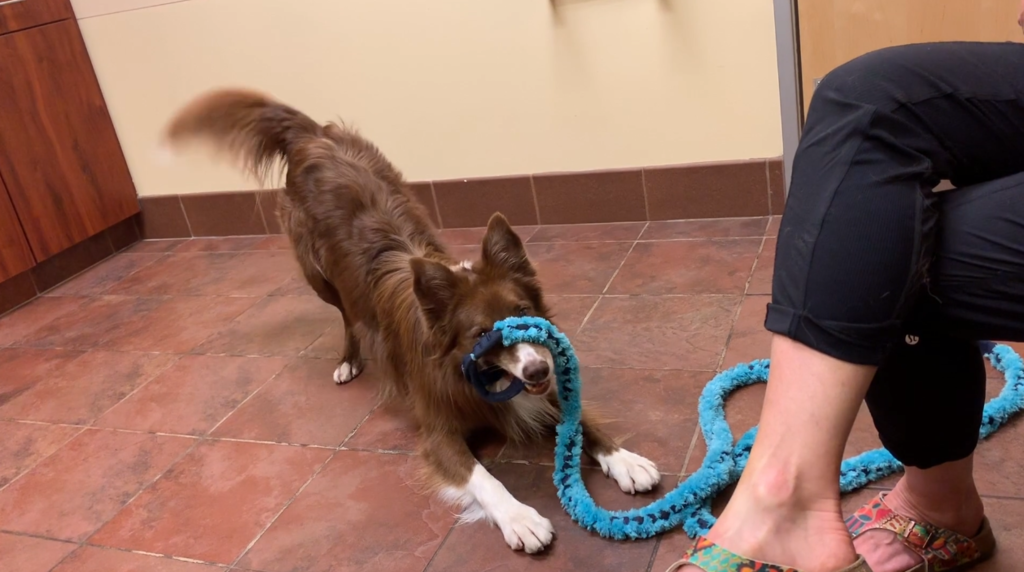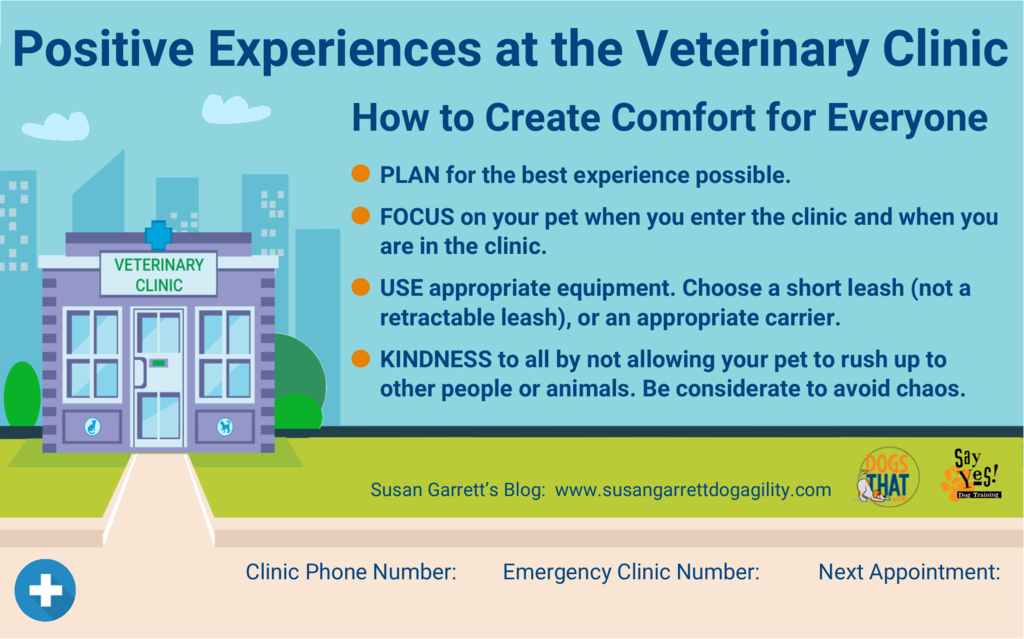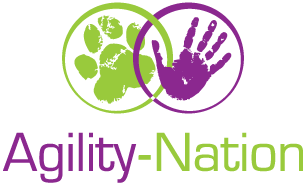One of the many things that unite us as dog lovers is that we will all have to take our dog to visit the vet. This can be a harrowing experience for our animals, but it does not need to be that way. More and more veterinary clinics are becoming accredited “fear free” and make sure that their environment and processes are as low stress as possible for pets and people.
There are three key areas that you can focus on to help make a visit to a Veterinarian as positive an experience as possible for all involved. That’s what I’m covering in the video below.
You can also check out our YouTube Playlist on cooperative care to help with giving your dog medication, eyedrops, cleaning ears, nail trimming, grooming, being held and much more.
Keys to Creating a Positive Experience
Intentional and Experiential Conditioning
There is intentional conditioning and experiential conditioning. Aim for INTENTIONAL conditioning, focusing on the following four areas:
- The Veterinary Clinic itself, the building, the parking lot, the smells. Call your vet and arrange for a visit in off-peak hours so you can create a positive experience for your pet.
- Wearing a muzzle. If your pet is in a lot of pain, he might not want anyone near him. A muzzle will allow your pet to be treated and keep everyone safe.
- Being held. Many animals do not like being restrained. Hold your pet, give him a cookie and let him go. Start gradually and work up to other people holding your pet.
- Condition your pet to a carrier, cage or crate. Set up a positive experience! Build comfort and confidence and avoid any anxiety your dog or cat may have for being in a confined space or crate. Crate Games is going to help you condition your dog to a crate for comfort and confidence.
Planning for the Best Possible Experience for All
If you know you will be visiting the vet, prepare beforehand. Set out your treats, lead, carrier. Have a plan for what your visit looks like when you arrive at the vet. Plan for the best experience possible.
If your pet is reactive, it’s important to set him up for the best experience along with everyone who will be in contact with your pet. Everyone wants the best for your animals. Let your vet know ahead of time that your pet is reactive. Tell your vet how you will be arriving and what you are going to do to get to the examination room. Your vet might even have a reactive pet protocol.
Taking Action for Comfort Not Chaos
- Have your focus on your pet when you enter the clinic (put your phone away).
- Use appropriate equipment (a short leash rather than a retractable leash).
- Don’t allow your pet to rush up to other people or animals.
- Be considerate and kind to avoid chaos for everyone.

Swagger happy and relaxed in the consult room.
Following the simple and easy guidelines above can make a big difference to not only your dog but to everyone else who might be at the Veterinary Clinic.
What do you do to create a positive experience as possible for your dog (or cat, or other pet)? Let me know in the comments your top tips.
We can do more as well to help our pets with focused training. Not too long ago I was able to interview Madelynn Hettiger in a look “Behind The Scenes At Shedd“, and Madelynn shared about the training to help a Great Horned Owl have his eye worked on by a veterinarian without restraint or sedation. It’s important for animals to be happy and cooperate in their own care and the training outlined by Madelynn has many parallels with what we do in our dog training.
Today I am grateful for all the amazing Vets and Vet Support Staff in this world who do their utmost to help our animals. Next time you are at your Veterinary Clinic, let them know how much you appreciate all they do.

Save this image and use for quick easy access to key tips and your Vet’s contact details. To print for a handout, click on the image above to open a PDF to save.






Brilliant as always! Ty!
I love the article and the comments. My new puppy is mat trained and we take her mat with us. When she’s on it, she knows nobody bothers her and fun things will happen, even when scary dogs are around. We take it wherever we go. Vets are far away here, but I want to begin desensitizing her to things we do now that she’s spayed.
My dog (3 year old Mudi) is very anxious and suspicious at the vets. But my vet is amazing! I visit them once a week in their lunchbreak (no other animals there) and i do scent games (wich he loves) to coutercondition the rooms. And try to work to get him to play with toys, but so far I can only play with food. I am working on muzzle games and consent for treatments. No people involved yet, but we will get this!! Thank you for this amazing source, I am frequently checking it to stay motivated and not lose hope!!
I use a trip to the vet as an obedience training opportunity.
I have always aimed to keep our vet experiences as positive as I can. The dog that just passed had a lot of vets, & loved them all to the point that I could let him out of the car off leash, & he would pee & head for the door. At a couple of his vets I had to keep him busy, & tell him “it’s not your turn yet”. When it was his turn, they would wait for the path to be clear, & then give me a nod. At that point I would release him & he would race into the exam room. One of my younger dogs is almost the same. My newest “foster failure” is learning to do the same. This has been a tremendous help with the current situation where people can’t enter the clinics. Before this, I would always train behaviors while waiting, reward heavily, teach a chin rest, try to make it a fun outing.
Great info as usual Susan!
Sadly CBC Marketplace did a secret shopper episode on veterinarians and found most were price gouging, padding bills or incompetent.(the episode is still available on YouTube)
We need to seriously research a vet before hand. I too have experienced several cases of unethical vets.
Thanks for your information I am an avid follower.
Thanks for the information – makes a lot of sense. Will have to see if the Vet Office will let us stop by in advance to give cookies thru the door as owners aren’t allowed in now.
I have a puppy that needs a wellness checkup, but the vets aren’t allowing owners into the facility due to Covid 19. They come out to the car and get the dog, take it in and call you with the vet’s diagnosis. I’m hesitant to have a puppy that hasn’t seen a bunch of people (Due to stay at home restrictions) be handed over to a stranger and examined by the vet. I want to be there for him. I find this very frustrating. The pup has had his shots, since I give them to my dogs, so that isn’t an issue.
I think in some ways this is like what I do in a thunderstorm.(I HATE THEM) but I have trained myself to be upbeat and not feed any anxiety for our dog’s sake through the years…if they feel I am anxious, they will be also. So…the vet is a very special place to go and we make it a fun time, verbally, with a couple of snacks, with upbeat converstation with the medical staff, a new toy, scratches and rubs if they seem to want it. I like to go in first, leaving our dog with my husband in the car, and make sure that there are not any aggressive dogs waiting. If there are, I just wait until it quiets down and there is a room for us. Been going to the same vet since 1994 and they have always made comments on how friendly and well-behaved our dogs are. Usually, our dogs just lie down and take a nap until the vet comes in! We have a very old English Shepherd rescue who is not doing well, and has been to several vet visits lately. He hates men other than those in our family because of how he was captured and put in the dog pound. However, he has come to really like the folks at the veterinary clinic…I am so proud of him – We will miss him so much when he is not with us anymore. Hope this helps…really appreciate the comments made here and the ideas presented, Susan!
Susan and team,
You are so thorough! Thanks!
My dog Toby has been sick these past few days. Therefore, I have decided to start looking for an animal hospital for him, but I’m worried that going there might scare him off. Once I find the perfect vet clinic, I’ll keep in mind to visit during off-peak hours, so that my dog wouldn’t be afraid or overwhelmed.
I think it’s a great idea to have an intention to make your pet happy while at the vet. My dog needs to go in for a checkup soon and he seems to know when it’s coming. He doesn’t like to go but I think I can change that if I try some of your ideas to make it a more positive experience.
I liked your tip on putting a muzzle on your pet if they are in a lot of pain. My wife and I are preparing to bring our dog to the vet for the first time. I’ll let her know that we should get a muzzle for our dog if she is in a lot of pain.
I took my puppy to the vet every week for the first few months of his life, even if it was just to go say hi, practice a sit on the scales and then leaving again. I also conditioned him to be touched, held, hugged and prodded in any areas from a very early age. One thing he’s always hated was his front paws being touched or held but I played a game where i would hold his paw lightly, if he tries to pull it away I hold it tighter, if he relaxes, I let go. So now he automatically relaxes when someone touches his front paws. Whenever I say: “Shall we go see Dr Minty?” he can’t wait to get in the car and go. He practically drags me up the steps at the vet’s office and he loves meeting everyone there. We also play some small simple games while sitting in the waiting room as it keeps him occupied and reduces the waiting times. It’s always a fun outing to go to the vet.
I took my GSD puppy to puppy preschool at my local vet clinic. She loved going there and having playtime with other pups (it was after hours). She still loves going to the vet, however she is reactive to other dogs, so if they are in the waiting room she is very vocal and lunges. I leave her in the car when we arrive and check if any other dogs are there. If there are, the vet nurse moves them into another room so we can go straight into a consulting room and wait for the vet there. It works quite well. I always go armed with treats that she loves, such as cooked chicken. She has let the vet draw blood and take her temperature without any problems if I am feeding her treats and making it as positive an experience as possible.
We have a big, powerful girl (mastiff x lab). She is a rescue. Not only is she very dog:dog reactive, she doesn’t like to be touched on the paws, her rear end, or have anybody lean over her. We’re attempting desensitization but it’s taking a long time. The vet feels she most likely was repeatedly quicked and perhaps had a forceful breeding attempt. Right now, we depend on drugs, a muzzle and a clear path to the exam room.
Consistency, stay with the desensitizing. It is a long process and lots of rewards which may be their food. Instead of schlepping it down, make it an event where the food becomes valuable and part of their daily touch routine.
I have a small dog. She is so much more comfortable traveling in her carrier to the vet. She loves her comfy cozy carrier because it predicts car travel and it keeps her safe and secure in the vet’s office. And I know she is safe when I have to take my attention off her when paying or scheduling another appt.
Poncho is a Bullmastiff & Pitbull Mix. I have trained him. He gets nervous when we go to the vets. I give him his calmzzz tablets, that helps alot. Iam going to try going to the vet when its not busy. Get him use to this place.
I have a fearful dog , so going to the the vet does require pre-planning. She does wear a basket muzzle . She has never bitten anyone but she does not like to be approached from behind, so both the vet and I feel more assured by using a muzzle. We have worked on the wearing of a muzzle so she accepts it without a problem. I m confident in handling her, so there is never a need for a third person to help which also reduces any stress.
I do also have a tube of liver paste which I feed her and that also makes for a more rewarding environment for her.
Because she travels overseas with me every year, she has to have blood drawn annually for 5 various tests for her importation permit. It is a long procedure so the vet actually takes the blood while the dog is lying in her usual place in the back of my hatchback car which is much less stressful for her .
I have conditioned my dog to a muzzle- we have not had to use it but it gives us peace of mind knowing if needed my dog won’t panic. It also get her used to being restrained
My daughter and I pick her up and hold her upside down in play so she’s used to being handled in “weird” ways.
I’ve been conditioning her so she gives consent to be handled and trusts I listen to her. We use play doctors instruments and it’s pretty routine to be handled like she might be in a vets office.
She just went in for OFA xrays and they were easily able to do those with no sedation and got excellent xrays since she was co operative.
The one thing that really made a huge difference with my dog was taking her to the vet’s puppy classes when she was very small. Our vet had classes for puppies from the time of the first vaccination up to 14 weeks old. The shy puppies were separated from the more boisterous ones at first but it wasn’t long before they all joined in and had a lot of fun. They learned to play nicely and be held by other people as well as getting on the scales and being lifted onto the table. They had plenty of puppy toys and treats. My dog loves going to the surgery now.
I try to make as many deposits in the “love the vet” bank as possible .. starting with a well puppy check a few days after puppy arrives at my home.. always choosing an off peak time. There is some very gentle handling by the vet – only as much exam as pup seems to need and/or is comfortable with, and of course lots of gentle cuddles from other staff (who particularly welcome and benefit from that if they’ve been having a sad day.} I use the vet scales in the waiting room at non busy times to weigh the dogs regularly .. and of course they get treats and cuddles every time. I’ll sometimes have them do some “work” if the waiting room is empty. My vets also trust me to hold my own animals. My dogs seem to be able to generalise “love the vet” to other practices, … I make sure that they are always rewarded heavily for good calm behaviour
We are fortunate to be able to walk to the vet’s office. We drop in at least once/month to get weighed, have a treat and a pat.